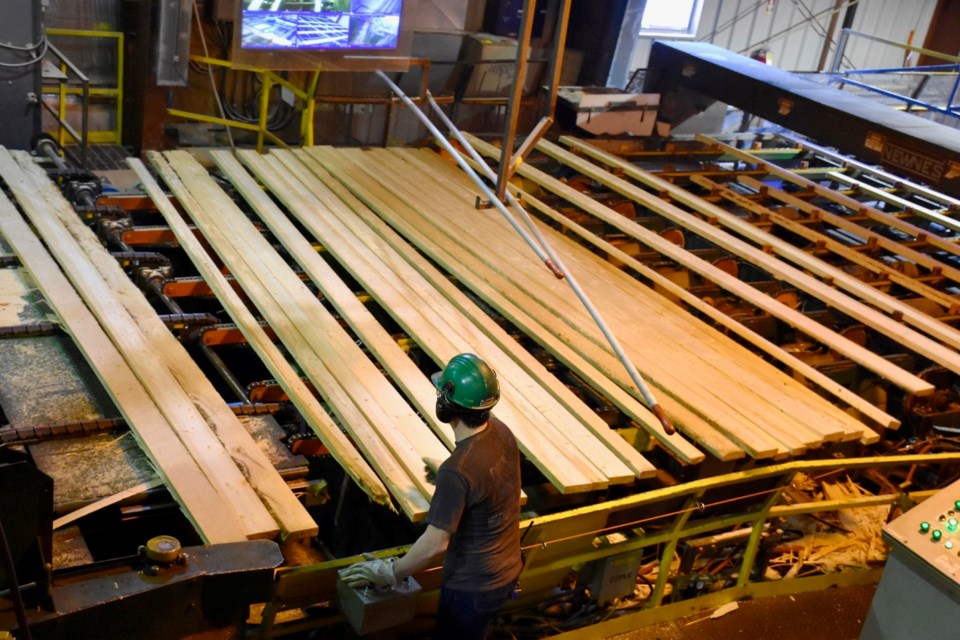Ontario’s forestry sector is feeling the weight of ongoing trade disputes and potential new tariffs.
In talks with the United States and industry leaders, Ontario Forest Industries Association (OFIA) president Ian Dunn said the message is about collaboration. To effect change, he said Americans have to talk to their administration.
OFIA represents 50 forestry companies in Ontario and works closely with provincial and federal governments to advocate for fair trade policies, Dunn said.
Dunn recently travelled to Washington, D.C., to stress the importance of free trade.
“I went with the province, other stakeholders, and other industries. The purpose of that was to make very clear to the American consumer the importance of forestry products,” Dunn said.
“We met with the National Association of Home Builders (NABH), a very important organization that represents the home construction industry in the U.S. Obviously, they're very concerned about the pricing of construction materials. They're looking for free trade, and they are a very loud voice.”
The meeting was held at the NAHB headquarters in Washington, followed by a reception with a U.S. senator, attended by various premiers from across the country, Dunn said.
“The message was all about collaboration. We're the biggest trading partners in the world, and how are we going to move forward from this,” he said.
“But at the end of the day, the Ontario industry is going to have very little sway or impact on the Trump administration. It's going to require Americans talking to their administration. And I can assure people that there's a lot of concern on the other side of the border as well.”
The softwood lumber dispute between Canada and the United States has been an issue for decades.
The most recent agreement ended in 2016, sparking a new wave of trade tensions, he said. Since 2017, duties have been imposed on every Canadian lumber shipment to the U.S., accumulating over $7 billion held in deposit by U.S. customs.
“That money could be used to reinvest into mills, make our mills more competitive,” Dunn said.
“But our lumber producers in the province have continued to face this challenge.”
This dispute, combined with additional broad-based tariffs — including a short-lived 25 per cent tariff on all forestry products — has created financial strain for producers.
Dunn warned that U.S. President Donald Trump’s recent national security investigation into foreign forest products and the deregulation of U.S. national lands for logging could further harm Ontario’s industry.
Dunn said the tariffs have caused fluctuations in exports, production, and pricing.
He noted that some American customers attempted to stockpile materials in anticipation of potential tariffs, leading to a temporary spike in shipments.
For segments like pulp and paper, which are vital to northeastern Ontario’s industry, any additional tariffs would pose a significant challenge.
“There isn't a member in our organization that has a 25 per cent margin,” Dunn said.
Impact on jobs and mill operations
Employment in Ontario’s forestry sector has already seen a steep decline over the past two decades, Dunn said.
He pointed to the reduction in timber harvesting — down from 28 million cubic metres in 2000 to 13 million cubic metres today — and the closure of numerous pulp and paper mills.
“There were 16 pulp and paper mills in Ontario in 2005 and currently there are three left operating,” Dunn said.
Kap Paper in Kapuskasing is among the list.
While economic downturns like the 2008 financial crisis played a role, Dunn believes trade barriers have contributed to mill curtailments, shift reductions, and layoffs in Ontario.
“With additional tariffs, I would imagine that would just accelerate, unless there is some support put in place for the industry,” Dunn said.
He added that OFIA is working with the province to secure necessary support and promote domestic markets.
Given the heavy reliance on the U.S. market — where 97 per cent of Ontario’s forestry exports go — Dunn sees diversification as a necessary step.
Geography is a challenge for Ontario to access European and Asian markets.
Domestically, he sees opportunity in addressing Ontario’s housing crisis by creating a locally driven forest products supply chain.
“We're really bad at building homes in Ontario. There's a housing crisis. There's a homelessness crisis. I think it's a real opportunity to make a completely made-in-Ontario forest products, home-building supply chain,” Dunn said.
“And the GTA is one of the biggest housing markets in the country. So, I think there's an opportunity there.”
Dunn said forest biomass energy production, biofuels, and other value-added wood products also present growth opportunities.
Despite the uncertainty, Ontario has advantages over other jurisdictions, including an abundant supply of high-quality spruce-pine-fir (SPF) lumber and northern bleached softwood kraft (NBSK) pulp, Dunn said.
For the industry to remain competitive, more investment in pulp and paper mills is needed to utilize residual materials from sawmills, he said.
While the road ahead will be difficult, Dunn is optimistic.
“It is going to be painful, and there's a lot of uncertainty about what will actually happen at the end of the day. I'm hopeful that there will be a settlement on a softwood lumber dispute. I'm hopeful that Canada and the U.S. will find a path forward on tariffs in general,” he said.
“But, longer term, we have the resources here. We have the skilled workforce that is needed, and we have a government in place that's open for business. And I think with those three things, we're going to be set up for success in the future. And I think the future is bright, but it will be painful.”
— TimminsToday




